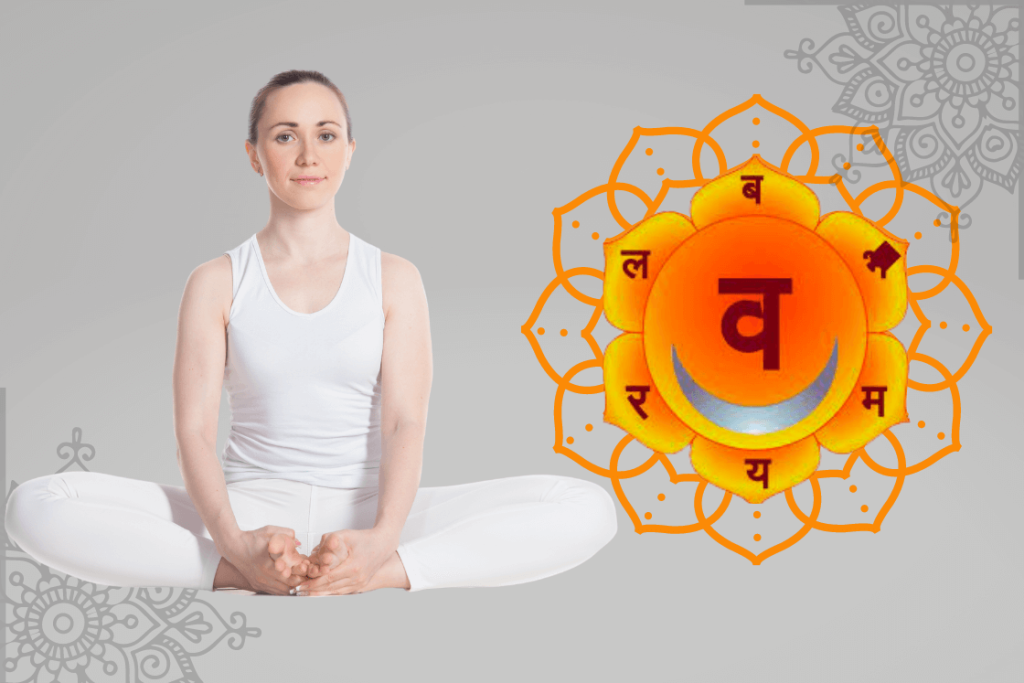
The sacral chakra, known as Svadhisthana Chakra in Sanskrit, is sometimes called the “Seat of Life”. It enlightens one on their individuality, which is demonstrated through their creativity, emotions, desires, pleasure-seeking karmas, etc.
Your ability to communicate your feelings in the best possible way is supported by the sacral chakra. We can relate the power of the sacral chakra to our ability to adapt and flow with life.
It is through this second chakra that we begin to interact purposefully with the world. It is our primary emotional source.
Lethargy, addictions, and the inability to adapt to change can result from the suppression of any of the above functions. Your mental and physical well-being can be negatively affected by blockages caused by the restriction of this essential energy.
Also read: How to know if the sacral chakra is balanced?
Yoga is one of the best ways to release and let go of blocked emotions and feelings, as they are often trapped in your body. It helps you balance your sacral chakra by strengthening and flexing your hips and all the muscles around your pelvis. You can release negative emotions such as guilt, shame, and envy by balancing your sacral chakra.
Understanding Sacral Chakra
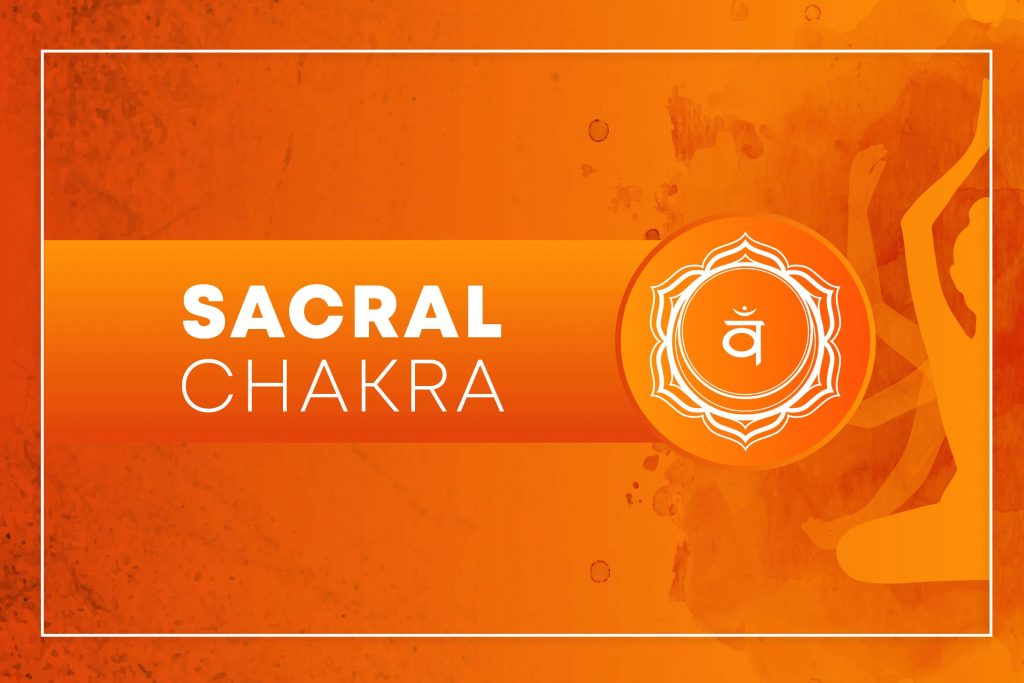
The sacral chakra is located in the lower abdominal region, in the area between the navel and the genitals. To determine its exact location, it is four finger widths below the navel. The sacral chakra not only regulates the water element in the body but is also responsible for the storage and distribution of Vyana Prana. The bladder, kidneys, and reproductive organs are also closely connected to it due to its location, which also helps to control the circulation of energy in this area of the body.
In this way, the sacral chakra is also connected to the ovaries in females or the testicles in males.
A warm and exciting energy emanates from the sacral chakra. It is related to our sexuality, sensory cravings, emotions, and creativity, and it controls how much joy and pleasure we experience in life.
When the sacral chakra functions properly and in harmony, a person can enjoy their senses in moderation while managing their emotions and interpersonal connections. An individual can then establish close relationships and learn about their capacity for decision.
When the sacral chakra is out of balance, a person may have feelings of guilt when having sex, uncertainty about their own emotions, overactive feelings, and addictive behavior.
Back pain, reproductive system malfunction, a sudden ache in the lower abdomen, renal and urine issues, and other symptoms also start to appear.
Yoga Poses for Sacral Chakra
Yoga poses for the sacral chakra are targeted toward the hips. You can remove stress and sluggish energy that might be obstructing the sacral chakra’s energy flow by expanding the hips. This aids in re-establishing the chakra’s equilibrium and energy levels.
Yoga positions can help with emotional discharge because the sacral chakra is strongly related to emotions. You can provide a place for any repressed feelings or energetic blocks to come to the forefront and let go when you perform postures that focus on the sacral chakra. A higher level of emotional stability and openness may result from this.
Additionally, you can awaken and regulate the energy of the sacral chakra by stimulating the flow of that chakra’s energy through physical activity. Furthermore, you may stimulate and boost your sensuality and access your creative energy by concentrating on the sacral chakra as you perform these poses.
Most significantly, establishing an optimal flow of prana in the body is made possible by harmonizing the sacral chakra through yoga poses. One’s general energy, sense of well-being, and a closer connection to their creative potential are all supported when the sacral chakra is in balance and energetically vibrant.
Keeping the above in mind, below are some such yoga poses that can help maintain balance in the sacral chakra:
Yoga poses can be beneficial for the sacral chakra in several ways. The sacral chakra, also known as Svadhisthana, is the second energy center in the body and is associated with creativity, sensuality, emotions, and the flow of energy. Here’s how yoga poses can be beneficial for the sacral chakra:
- Hip Opening: Many yoga poses that target the sacral chakra involves hip-opening movements. By opening the hips, you can release tension and stagnant energy that may be blocking the flow of energy in the sacral chakra. This helps to restore balance and vitality to the chakra.
- Activation and Stimulation: Yoga poses engage and activate the muscles and energy centers associated with the sacral chakra. Through physical movements, you stimulate the flow of energy in the sacral chakra, helping to awaken and balance its energy.
- Emotional Release: The sacral chakra is closely linked to emotions, and yoga poses can facilitate emotional release. As you practice poses that target the sacral chakra, you create a safe and supportive space for any suppressed emotions or energetic blockages to surface and be released. This can lead to a greater sense of emotional well-being and openness.
- Sensuality and Creativity: Yoga poses for the sacral chakra often involve movements that promote a sense of grounding and connection with the lower body. By focusing on the sacral chakra during these poses, you can awaken and enhance your sensuality and tap into your creative energy. This supports a greater sense of pleasure, passion, and creative expression in your life.
- Energy Flow and Vitality: Balancing the sacral chakra through yoga poses helps establish a harmonious flow of life-force energy (prana) in the body. When the sacral chakra is balanced and energized, it supports overall vitality, well-being, and a deeper connection with your creative potential.
Bound Angle Pose (Baddha Konasana)
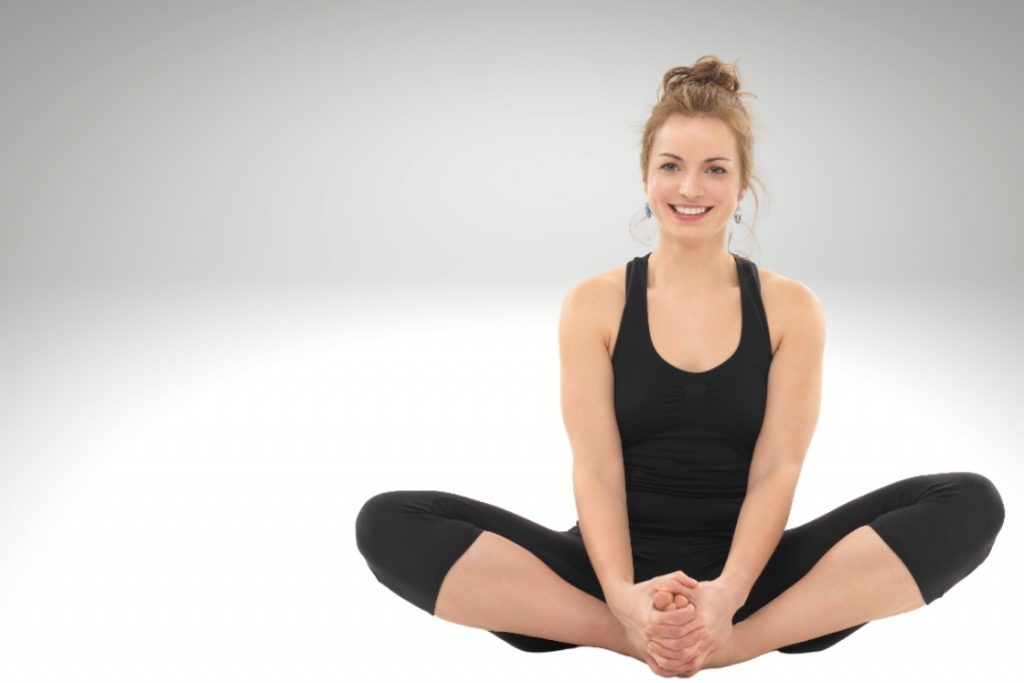
The bound angle pose is an excellent sacral chakra pose as it directly targets the lower abdomen. It stretches and strengthens the hips, groin, and pelvic floor muscles. By activating the sacral chakra, it promotes the release of accumulated stress in the hip region.
Since it works on the pelvic floor, it also stimulates the organs that reside in that area. Thus, it also helps relieve symptoms of sacral chakra imbalance such as hormonal and menstrual problems, infertility, sexual dysfunction, etc.
Steps to perform
- Sit in Dandasana (Staff pose).
- Bend your knees turning the soles of both feet turned towards each other. Join the soles as you bring your legs closer to your groin.
- Bring your feet as close to your groin as possible, depending on your flexibility.
- You can increase or decrease the gap between the feet and the groin to avoid any strain or pain.
- Try bringing your knees close to the ground, if your flexibility allows. Else you can place yoga blocks or rolled blankets under the knees for support.
- Make sure that your spine is not curving as you hold your feet to keep them together.
- Hold the pose for 3-5 breaths.
Bridge Pose (Setu Bandhasana)
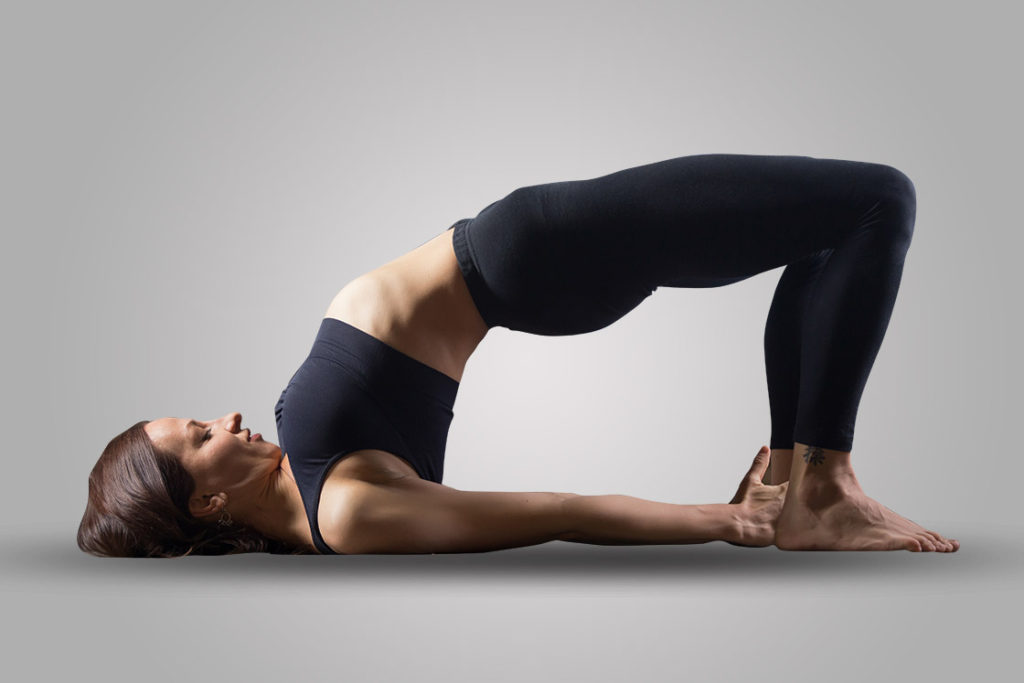
This position helps to ease pain, stiffness, and tightness in the hip joints by stabilizing them. The sacral chakra, which is located near the rectus muscle and the urinary tract, are both pressed as you push your hip up in the posture, which is excellent for treating urine incontinence.
The bridge posture teaches you to become one with your inner self and to communicate and interact with others.
Steps to perform
- Lie down on your mat with your legs bent and spread them hip-width apart. Make sure your lower legs are parallel to each other.
- Place your arms beside you, palms facing down.
- Engage your core and firmly plant your soles on the mat to lift your hips. Use the support of your arms here by pressing them down as well.
- Keep pressing down your soles as you lift your thighs, hips, lower back, and upper back. Stop when only your shoulder blades and head are on the mat.
- Hold this position for 3-5 seconds.
Pigeon Pose (Eka Pada Rajakapotasana)
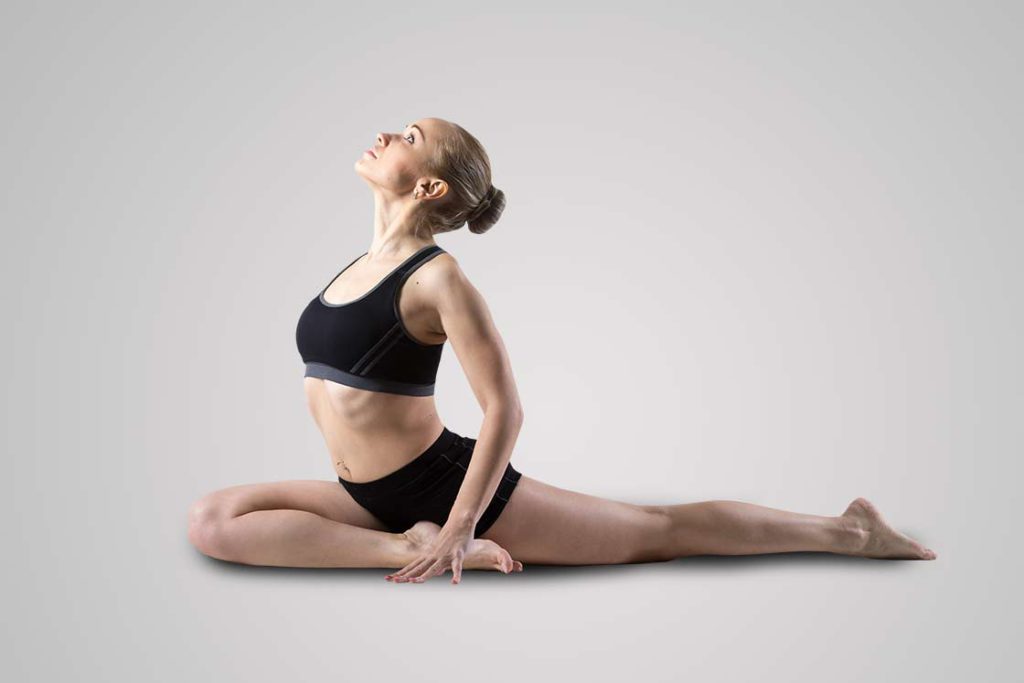
The Pigeon Posture stretches both the short hip rotators and the hip flexors, which makes it great for releasing tension while maintaining hip stability. It also targets the pelvic muscles and the related reproductive organs making it a beneficial pose for women with hormonal imbalances, infertility, menstrual symptoms, or Polycystic Ovary Syndrome (PCOS).
Through this pose, you will be able to assess your emotional stability in challenging conditions, making it an ideal pose for maintaining balance in the sacral chakra.
Steps to perform
- Come to the tabletop position.
- Bring your right knee to your right wrist and place it behind the wrist or on the outside of the inner edge of the wrist, as per your flexibility.
- Turn your lower leg such that your right ankle is placed almost in front of your left hip. If possible, make sure that your lower leg is parallel to the shorter end of the mat.
- Slide your left leg back and place the top of your left foot on the ground.
- Your hips should be squared to the front of your mat. To make the pose more comfortable, place a folded blanket or towel beneath the right side of your hip.
- Hold this pose for 3-5 breaths and repeat with the other leg.
Goddess Pose (Utkata Konasana)
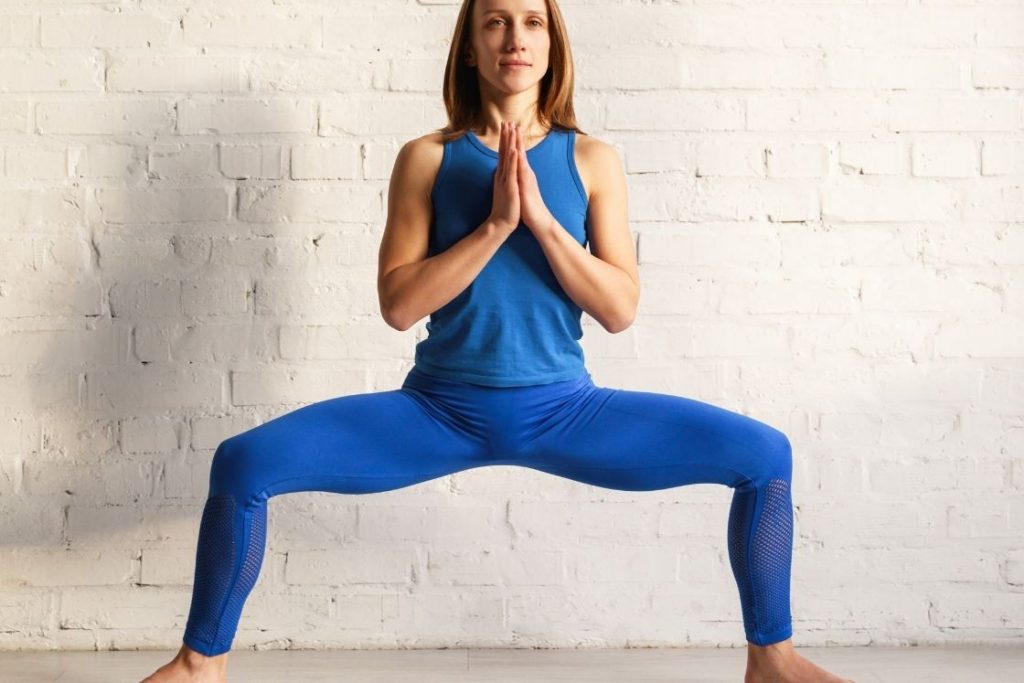
The goddess pose is a powerful hip opener that activates the entire lower body. Utkata Konasana strengthens your calves, quadriceps, glutes, and core while stretching the adductor muscles in your inner thighs.
The Sacral Chakra is activated by widening the hips and pelvis in Utkata Konasana, improving self-esteem, and unleashing creative, sexual, and reproductive energies.
Goddess Pose is a fantastic exercise for all women. It aids in easing hormonal imbalances or menstruation problems, which are common symptoms of an imbalanced sacral chakra.
Steps to perform
- Stand in the mountain pose and spread your legs shoulder-width apart. Tilt your toes outwards at 45 degrees.
- Lower down till your thighs are parallel to the ground. Your knees should be stacked over your ankles.
- Engage your core muscles and pull in your navel to keep your back straight.
- Spread your fingers and extend your hands above your head, bending them at the elbows. The elbows should form a 90-degree angle and the upper arm should be parallel to the thighs. Face the palms towards the front.
- Hold the pose for 3-5 breaths.
Triangle Pose (Trikonasana)
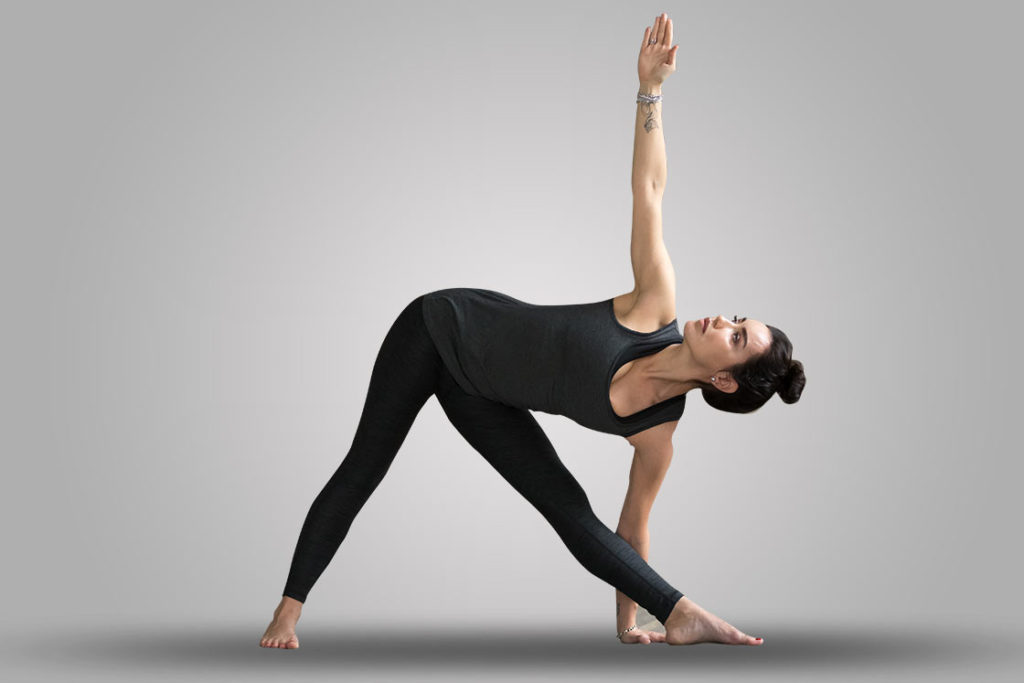
The triangle pose effectively counters the effects of the imbalance in the sacral chakra as it governs the reproductive organs and energies in both men and women. By opening the groins and inner thighs and toning the pelvic region, this position strengthens the genitalia and the urinary glands.
It is beneficial in relieving menopausal symptoms and period inconsistencies in women and infertility, erectile dysfunction, and prostate gland diseases in males.
This energizing pose is extremely effective in improving prana circulation which will help open and remove blockages in the sacral chakra.
Steps to perform
- Stand in Tadasana (Mountain Pose) with your feet shoulder-width apart.
- Turn your left foot diagonally while the right foot is towards the front. Make sure your heels are aligned.
- Spread your arms sideways, parallel to the ground, with your palms facing down. Your shoulders should be away from your ears.
- Bend towards your right foot from your hips, as you bring your right arm down with you and your left arm moving upwards.
- Bend as far as you can. Typically, your fingers should touch your right foot. You can also use a yoga block at its highest side to rest your right hand.
- Your arms should form a straight line horizontally with the shoulders stacked on top of each other.
- Turn your head to gaze at your left fingertips.
- Hold this pose for 3-5 breaths and repeat the with the other leg.
Seated Forward Bend (Paschimottanasana)
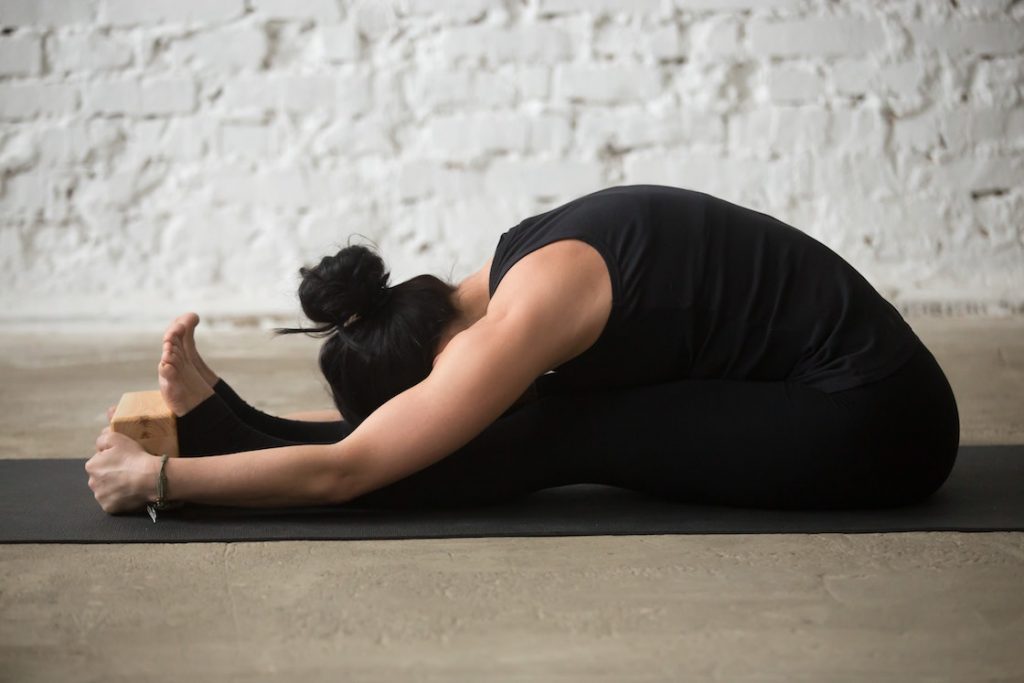
The lower back, hips, and hamstrings are all significantly stretched when performing the seated forward bend. As a result, the ovaries and adrenal glands are able to operate regularly and blood circulation to the pelvic area is enhanced.
This pose also releases stiffness from the pelvic and hip region which is good for detoxification and providing free flow of prana to the sacral chakras.
Steps to perform
- Sit in a staff pose (dandasana) and place your palms on the floor beside your hips.
- Bend forward from the hips without rounding your back. Your head should also be aligned to the spine instead of tilting forward.
- Slide the arms forward as you bend and take them as far as you can stretch outside of each leg.
- Keep bending when you feel you can no longer go further. You can also keep a cushion or a bolster on your legs to rest your torso and head.
- Hold the side of your feet with your hands if possible. Else you can loop a strap around the balls of the feet and hold the ends of the strap.
- Stay in this pose for a minimum of 3-5 breaths.
Incorporating Yoga into a Chakra-Balancing Practice
Sacral chakra poses are all about stretching and strengthening the pelvic floor, groin, and hip muscles. Going through the above poses will give you a fair idea of the importance of keeping the lower abdominal region flexible and stimulating.
Practicing such poses will ensure that the range of motion of your hip joints is increased, you experience less lower back pain, your internal organs in the area of the sacral chakra function effectively, and your reproductive system works optimally.
These poses are not only working on the physical aspect of your body such as the joints, muscles, and organs but also on the subtle body. By practicing sacral chakra poses, any blocked energy also gets released which ensures proper prana flow to the chakra and other parts of the body as well.
To keep the sacral chakra active, it is beneficial to include a mixture of such poses in your yoga routine. You may also take out time to specifically dedicate a yoga routine for the sacral chakra.
To complement your yoga poses, you can incorporate other techniques for maintaining the balance of the sacral chakra.
You can use sacral chakra crystals and stones such as citrine, orange quartz, amber, and orange moonstone in the space you perform yoga poses. Meditating on the sacral chakra can also prove to be beneficial to bring forth your emotions and creativity.
While meditating, it can be beneficial to repeatedly chant the seed sound “Vam” to energize your sacral chakra.
The food you consume also drastically affects the function of the sacral chakra. So, consume fruits and vegetables that are watery and include some mild spices in your diet.
Conclusion
If you are displaying extreme mood swings, feeling disconnected from your surroundings, experiencing excessive sexual urges or lack thereof, lethargic, low creativity, etc, it should be understood that your sacral chakra is imbalanced.
Being the second chakra, it is important to keep it activated and stimulated in order to feel your emotions, tap into your creative abilities, and build a healthy and loving relationship with yourself and others.
Practicing yoga poses is one of the best ways to keep the sacral chakra activated and balanced. Include a combination of the above poses or all of them in your daily routine. You can also level up sacral chakra poses once you feel that you have become comfortable in these.




